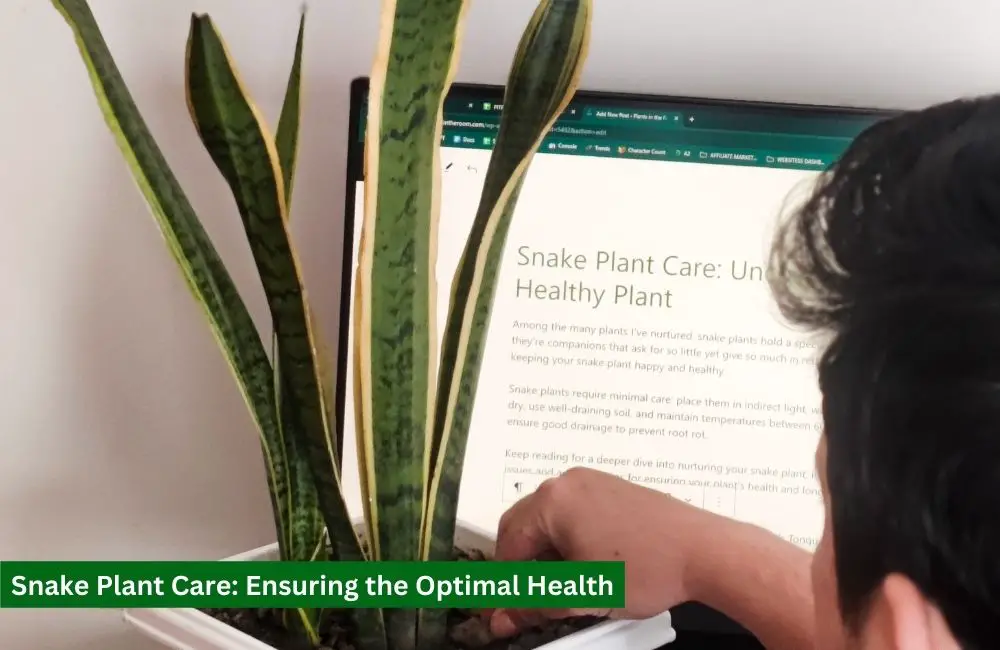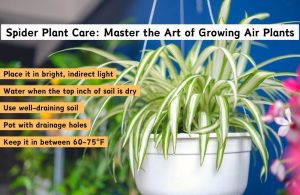This article covers the following areas –
- Light and Location: Finding the Sweet Spot
- Watering: Less is More
- The Right Soil and Pot
- Temperature and Humidity: Keep it Comfy
- Feeding: A Little Goes a Long Way
- Addressing Common Issues
- Final Words: Enjoy the Journey
Among the many plants I’ve nurtured, snake plants hold a special place. Why? They’re not just decor; they’re companions that ask for so little yet give so much in return. Let’s unravel the secrets to keeping your snake plant happy and healthy.
Snake plants require minimal care: place them in indirect light, water only when the soil is completely dry, use well-draining soil, and maintain temperatures between 60-80°F. Overwatering is common, so ensure good drainage to prevent root rot.
Keep reading for a deeper dive into nurturing your snake plant, including troubleshooting common issues and additional tips for ensuring your plant’s health and longevity. Let’s start with some basic information about snake plants.
Snake plants, also known as Sansevieria or Mother-in-Law’s Tongue, are renowned for their resilience and air-purifying qualities. They come with thick, upright leaves that have unique patterns. Perfect for both beginners and those with a crowded plant collection, they forgive the occasional neglect.
Aside from their striking appearance, snake plants can improve indoor air quality. They’re one of the few plants that convert CO2 to oxygen even at night. Plus, they’re believed to filter out toxins like formaldehyde and benzene. Pretty cool for a plant, right? Now, let’s begin caring for our snake plants.
Light and Location: Finding the Sweet Spot
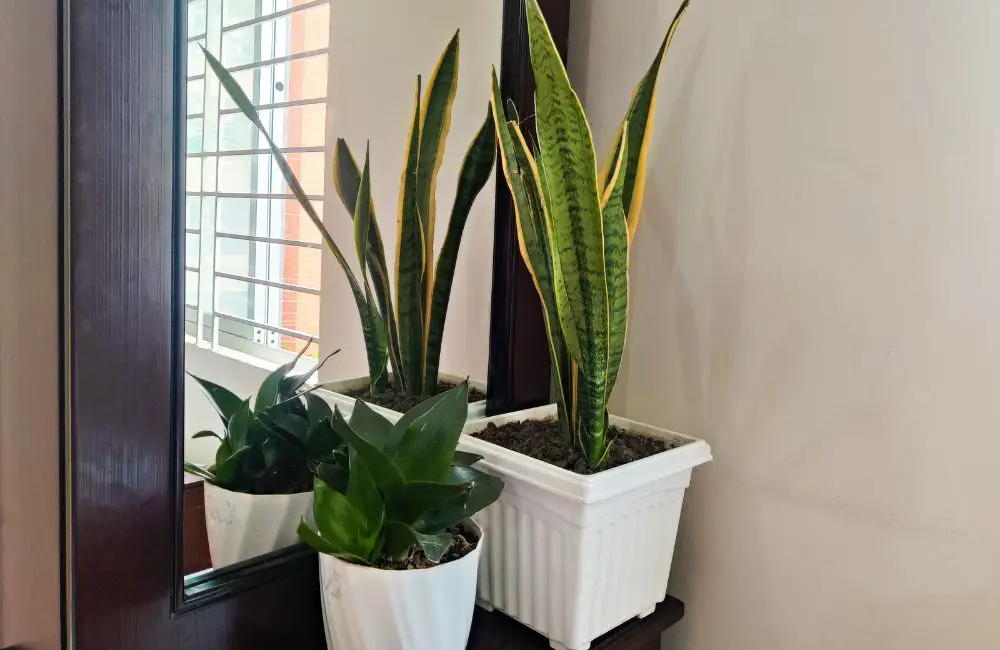
Snake plants are like that friend who’s easygoing and fits in everywhere but still has their favorite hangout spot. They love indirect light because it’s like enjoying the sun without getting a sunburn. A north-facing window is a great choice for them. It’s like a cozy spot where they get enough light but don’t have to wear sunscreen.
If you’re living in a place that’s more like a cave than a greenhouse, don’t worry. Snake plants can still be your green buddies. They can handle low-light conditions pretty well. Think of them as your friend who’s okay with staying in and watching movies instead of going to the beach.
But let’s say you’ve got a sunny spot to grow tomatoes. In this case, you’ll want to play it cool with your snake plant. Too much direct sunlight is like making them sit in the hot seat—uncomfortable and harmful. Use sheer curtains to soften the sunlight, like giving your plant sunglasses.
Remember, the perfect spot changes with the seasons. The sun takes a different path across the sky in summer and winter. You might need to move your plant around to keep it in its happy place. It’s like adjusting your chair to stay in the shade of a tree.
Lastly, if you’re unsure about the light, observe your plant. If the leaves start getting lighter or the plant seems to be stretching out, it might ask for more light. Conversely, brown or scorched spots mean it’s time to move it away from the light. Listening to your plant is key—it’s like it’s texting you its needs.
Watering: Less is More
Watering your snake plant is like making a perfect cup of tea. You wouldn’t keep pouring water into your tea once it’s just right. Similarly, snake plants need you to know when enough is enough. Stick your finger into the soil until the first knuckle; it’s time to water if it feels dry. If it’s still damp, wait a bit longer. This simple test saves you from the guesswork.
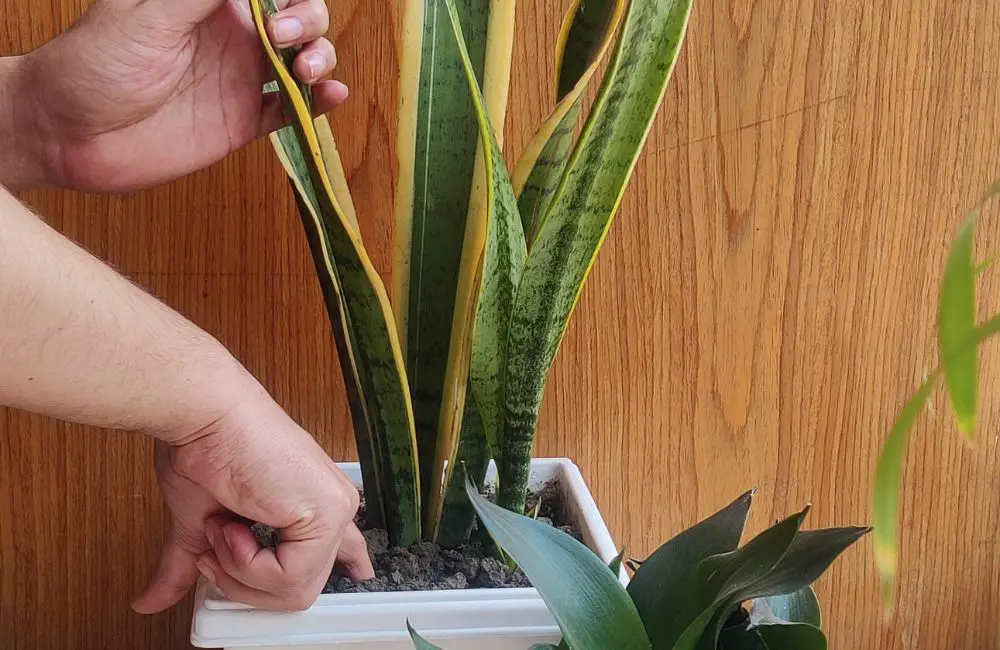
Imagine your snake plant is on a desert adventure. In the desert, water comes rarely but in deep, soaking bursts. When you do water your snake plant, do so thoroughly, allowing water to reach deep into the roots. Then, let the soil dry out completely before the next watering. This mimics the natural rainfall pattern your snake plant loves.
Winter is like a little hibernation period for your snake plant. It’s when they slow down and use even less water than usual. During these cooler months, you might water the plant just once a month or even less. It’s a rest period that prepares your plant for the growth spurt in spring and summer.
Overwatering is the Achilles’ heel for snake plants. They store water in their leaves, making them susceptible to rot if their soil is too soggy. If you’ve been a bit overzealous with watering, and the leaves start to get mushy or fall over, it’s a cry for help. Cut back on the water, and let the soil air out.
Watering your snake plant is about balance and tuning into its needs. Less is indeed more, and with a little attention, you can master the art of keeping your snake plant hydrated just right. Remember, every watering is an opportunity to connect with your plant, understand its rhythm and cycle, and ensure it thrives under your care.
The Right Soil and Pot

Choosing the right soil and pot for your snake plant is like picking a comfortable house with a good drainage system. You wouldn’t want your home to be flooded, right? Similarly, your snake plant needs a cozy spot that won’t hold onto water for too long.
A succulent or cacti mix is your go-to because it’s like a well-aerated bed for your plant. These mixes usually contain sand or perlite, which helps water flow through more easily, ensuring the roots aren’t sitting in moisture. It’s like having a built-in drainage system in the soil.
When it comes to pots, think of them as shoes for your plants. Just like you wouldn’t want to wear shoes that trap all the moisture around your feet, your snake plant needs a pot that lets excess water escape. That’s why drainage holes at the bottom are non-negotiable. They’re like the breathable fabric of a good sneaker, letting air and water flow freely.
But here’s a pro tip: even if you have a pot with drainage holes, consider adding a layer of gravel or broken pot pieces at the bottom. This extra step ensures even better drainage, acting like a filter that prevents soil from clogging up those crucial escape routes for water.
Lastly, while choosing the right pot, remember that size matters. A pot that’s too big for your snake plant can hold too much water, increasing the risk of root rot. Pick a pot that’s just the right size for your plant’s current stature, with a little room to grow. This way, you’re creating the perfect environment for your snake plant to thrive in, ensuring it has everything it needs to grow strong and healthy.
Temperature and Humidity: Keep it Comfy
Creating a comfortable environment for your snake plant is like setting up the perfect room temperature for a relaxing day at home. They enjoy a climate that’s not too hot or cold but just right. Keeping your snake plant in a room within the 60-80°F (15-27°C) range ensures it feels cozy, allowing it to thrive.
Just as you’d avoid sitting in a drafty spot during winter, your snake plant dislikes cold drafts too. Placing it near a drafty window in winter could stress it out, leading to poor growth or even damage. It’s like giving your plant a warm blanket by keeping it in a consistently warm spot.
When it comes to humidity, snake plants are not divas. They’re pretty flexible and can handle the average humidity found in most homes. This means you don’t need to fuss over humidifiers or dehumidifiers. It’s akin to a person who’s comfortable in various types of weather—whether it’s a bit dry or a tad moist, your snake plant will likely be just fine.
However, if you live in an exceptionally dry climate, occasionally misting your snake plant can mimic the natural humidity it would experience outdoors. But don’t overdo it; remember, they’re more tolerant of dry air than overly moist conditions.
So, keeping your snake plant happy is all about avoiding extremes. If you maintain a stable, comfortable temperature and don’t worry too much about humidity, your snake plant will be a content companion in your home. It’s all about finding that sweet spot where your plant can peacefully exist, much like creating a comfortable living space for yourself.
Feeding: A Little Goes a Long Way
Feeding your snake plant is like seasoning your favorite dish—a little can enhance the flavor, but too much can spoil the whole meal. When your snake plant grows in spring and summer, some fertilizer is a nice pick-me-up. Think of it as giving your plant a little energy drink to help it grow stronger and healthier.
Choosing a balanced, water-soluble fertilizer is key. Imagine it as a complete meal for your plant, providing all the nutrients it needs in just the right proportions. Diluting it to half-strength is like ensuring the meal isn’t too rich, preventing nutrient overload, which can harm your plant more than help it.
Feeding your snake plant every 6-8 weeks during its growing season strikes the perfect balance. It’s enough to support its growth without overwhelming it. Just as you wouldn’t want to eat a heavy meal daily, your snake plant doesn’t need to be fertilized too frequently.
When fall and winter roll around, your snake plant slows down and takes it easy, much like animals hibernating. During this time, it’s best to skip the fertilizer altogether. It won’t need the extra nutrients because it’s not trying to grow much. The rest period prepares your plant for the next growing season.
In essence, fertilizing your snake plant is all about moderation and timing. By understanding its needs and adjusting your care accordingly, you ensure your snake plant stays healthy and vibrant all year round. It’s a simple yet effective way to show your plant some love, helping it to flourish under your care.
Addressing Common Issues
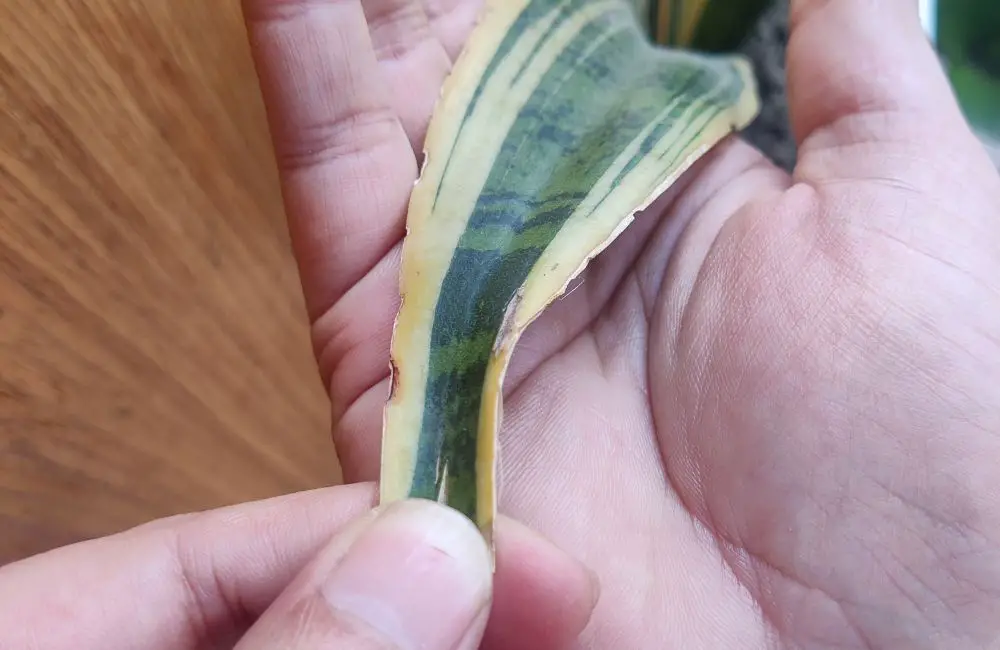
Even the most resilient plants, like snake plants, can sometimes run into problems. But don’t worry; most of these issues are easily fixable once you know what to look for. Understanding the cause is the first step to getting your plant back to its best health, whether it’s droopy leaves or brown tips.
1. Droopy or Yellow Leaves
When your snake plant’s leaves start looking more like a sad emoji than their usual perky selves, it’s time to check your watering habits. Droopy or yellow leaves are your plant’s SOS signal, mainly pointing towards overwatering. It’s like your plant is wearing its raincoat indoors; it’s just too much water for it to handle.
To turn things around, first, let the soil completely dry out. Think of it as a dry spell after a long rainy season. This break from water allows the roots to breathe and recover. After all, everyone needs a little breathing room now and then, right?
Adjusting your watering schedule is next. If you’ve been watering on a set schedule, consider changing it to a more flexible routine based on the plant’s actual needs. Before you water, do the finger test: stick your finger about an inch into the soil. If it’s dry, it’s time to water; if not, give it more time.
Remember, snake plants are more drought-tolerant than they are fond of water. They store moisture in their leaves, so too much water can lead to problems. It’s like having a pantry full of food and continuing to stock up; eventually, it’s just too much.
Finally, ensure your pot has good drainage and the soil is well-draining. This combo acts like a good insurance policy against overwatering, ensuring any excess water has a way out, preventing it from settling around the roots and causing issues.
By remembering these tips and adjusting your care routine, you can help your snake plant recover from droopy or yellow leaves and return to its vibrant, upright self. It’s all about understanding and responding to your plant’s needs, ensuring a long, healthy life under your care.
2. Brown Tips
Seeing brown tips on your snake plant can be a bit disheartening, but it’s usually a fixable issue. Think of these brown tips as your plant’s way of telling you it’s not entirely happy with its current situation. The culprits? Often, it’s down to the air being too dry or something in the water that doesn’t agree with it.
If you suspect low humidity is the problem, especially during winter when indoor heating can dry out the air, consider increasing humidity around your plant. You don’t need to turn your home into a tropical greenhouse; simply placing a small humidifier nearby or grouping your plants together can create a more humid microenvironment. It’s like giving your plant a bit of a spa day every day.
Switching to distilled or rainwater can be a game-changer if the issue is with your tap water. Tap water often contains fluoride and other chemicals that some plants are sensitive to, leading to brown tips. Using distilled or rainwater is like offering your plant a pure, clean source of hydration, free from those potentially irritating chemicals.
It’s also worth noting that while snake plants are pretty tough, they do appreciate consistency. Sudden changes in their environment, like moving them from a humid to a dry room, can stress them out, leading to symptoms like brown tips.
Regularly trimming off the brown tips can help keep your plant looking its best. Use clean, sharp scissors to snip just above the discolored area, being careful not to cut into the healthy, green part of the leaf. This tidying up is more than just cosmetic; it can help prevent any potential problems from spreading.
In summary, addressing the issue of brown tips on your snake plant is often a matter of tweaking the humidity levels around it or switching to a different type of water. With these adjustments, you can help your plant stay healthy and maintain its lush, green appearance. Remember, every plant has its preferences, and part of the joy of plant care is learning exactly what makes your green companions thrive.
Final Words: Enjoy the Journey
Caring for a snake plant is more about understanding its simple needs than having a green thumb. With these practical tips, your snake plant will not only survive but thrive, bringing a piece of nature’s resilience into your home.
Remember, every plant has its personality, so enjoy getting to know yours and watch as it grows alongside you.

